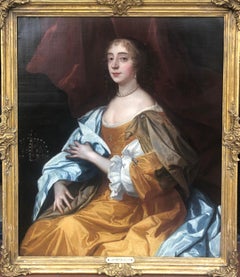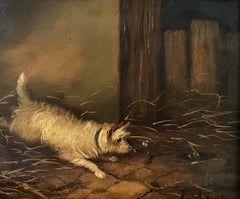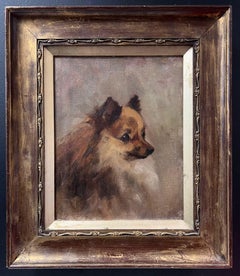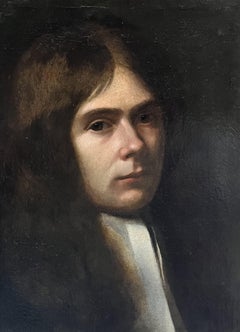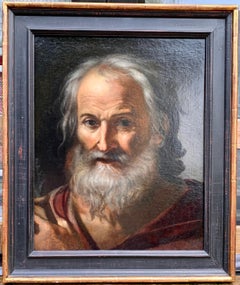1660s Portrait Paintings
to
1
2
Overall Width
to
Overall Height
to
730
1,232
3,982
8,834
125
86
181
217
167
247
275
324
198
264
339
1
2
2
2
1
1
1
2
2
1
2
2
Period: 1660s
Portrait of William Stonestreet - Dutch Golden Age 17thC art oil painting
Located in London, GB
This superb Dutch Golden Age portrait is attributed to circle of Dutch artist Wybrand Simonsz de Geest. Painted in 1666 it is a full length portrait of a young William Stonestreet. He is holding the paw of a clipped little white dog with drapes and clouds beyond. (It was common practise to dress young boys in dresses up to the age of about 6 or 7 when they were 'britched' or wore britches). An excellent example of Dutch Golden Age art that wouldn't look out of place in a museum.
Wm Stonestreet 1666, Prebend of Selsely is inscribed top left.
Provenance. Berkshire estate.
Condition. Oil and canvas, 44 inches by 36 inches and in good condition.
Frame. Housed in an ornate gilt frame, 52 inches by 44 inches and in good condition.
Wybrand Simonsz. de Geest (16 August 1592 – c. 1661) was a Dutch Golden Age portrait painter from Friesland in the Netherlands. Wybrand de Geest was born and died at Leeuwarden. He learned painting from his father, Simon Juckesz, a stained glass worker. He studied later with Abraham Bloemaert. From 1614 to 1618 he travelled in France and Italy on a Grand Tour. In 1616 he met up with Leonard Bramer in Aix-en-Provence. While in Rome he became a member of the painters' circle known as the Bentvueghels. He earned the nickname 'De Friesche Adelaar', or "the Frisian Eagle". De Geest married Hendrickje Fransdr Uylenburgh in 1622, a niece of Saskia van Uylenburgh...
Category
Old Masters 1660s Portrait Paintings
Materials
Oil
$26,065 Sale Price
20% Off
Portrait of Bridget Drury Lady Shaw, formerly Viscountess Kilmorey
Located in London, GB
Sir Peter Lely (Soest 1618 – 1680 London)
Portrait of lady with a crown, possibly Bridget Drury Lady Shaw, formerly Viscountess Kilmorey, later Lady Baber (d.1696) c.1665
Oil on canvas
46 1/2 x 40 3/4 inches, Framed
42 1/4 x 36 1/4 inches, Unframed
Inscribed left [……….]Isabella
James Mulraine wrote the following for this piece:
This portrait dates to the middle of the 1660s, the decade when Lely’s career took off as successor to Sir Anthony van Dyck. At the Restoration Charles II had appointed him Principal Painter to the King and paid a pension £200 per annum ‘as formerly to Sr. Vandyke...’1 Lely had trained in Haarlem and he was in his early twenties when he came to London in 1643. He was an astute businessman and a wise courtier. In 1650 he painted a portrait of Oliver Cromwell (Birmingham Museum and Art Gallery) while maintaining links with the Royalist exiles through the 1650s. He had arrived in England as a painter of small-scale portraits and lush scenes of nymphs in landscapes in a Dutch style. His experience of Van Dyck in English collections transformed his painting. His lavish and alluring vision of Arcadia exactly captured the spirit of the Court and as Principal Painter he dominated English portraiture for the next twenty years. Lely ran a highly efficient studio along Netherlandish lines, employing a team of specialists like the drapery painter John Baptist Gaspars and young artists-in-training like Nicolas de Largilliere. He had numerous rivals during that period, and by 1670 he had introduced numbered standard poses to speed up production, while collaborating with printmakers for further revenue and advertising. He died in 1680 of a stroke while painting, working to the last.
The portrait, painted at a date when Lely’s poses and execution were still individual and inventive shows a lady sitting at three-quarter length facing away from the viewer. She has begun to turn towards the viewer, a pose with a long pedigree in art, first used by Leonardo da Vinci in the Mona Lisa (Louvre). She steadies her blue drapery where it might slip from her arm with the movement, a flash of realism beautifully captured. Like Van Dyck, Lely painted his female sitters in a timeless costume rather than contemporary fashion, showing a loose gown and floating silk draperies. It presented the sitter as a classical ideal. The portrait would not date.
The saffron dress may be the work of a drapery painter but the brown scarf must be by Lely himself, and appears unfinished, broadly sketched in behind the shoulder. The delicate blue glaze and nervous highlights suggest shimmering translucence. Lely was a master of painting hands – his hand studies are marvels of drawing – and the lady’s hands are superb, exactly drawn, delicately modelled and expressive. The fidgety gestures, clutching the gown, fiddling with the edge of the scarf, give the portrait psychological bite, suggesting the personality behind the calm courtier’s expression, adding to the sense shown in the look of the eyes and mouth that the lady is about to speak. The portrait’s language is Vandykian. The inspiration comes directly from Van Dyck’s English portraits of women. Lely owned Van Dyck’s Portrait of Lady Elizabeth Thimbleby and Dorothy Viscountess Andover (National Gallery, London) and the sitter’s costume quotes Lady Andover’s saffron dress and brown scarf. But Lely paints a generation who sat nearer to the ground and through a dialogue of expression and gesture he shows sitters who are more flesh and blood than Van Dyck’s.
The background with a column and curtain is different to those shown in most of Lely’s portraits of women. They tend to include trees or fountains, with a glimpse of landscape. But there are other examples. A portrait of the King’s reigning mistress, Barbara Villiers Duchess of Cleveland...
Category
1660s Portrait Paintings
Materials
Oil
Related Items
Fine British Victorian Dog Oil Painting Terrier in Barn by Mousehole, 19th C
Located in Cirencester, Gloucestershire
Artist/ School: J. Langlois, British 1855-1904, signed lower corner
Title: Chasing the Mouse!
Medium: oil on board, framed
framed: 6 x 7.5 inches
board: 4.75 x 6.75 inches
Proven...
Category
Victorian 1660s Portrait Paintings
Materials
Oil
Antique English Oil Painting Portrait of Pomeranian Dog 19th Century framed
Located in Cirencester, Gloucestershire
Portrait of a Pomeranian Dog
English artist, late 19th century
oil on canvas, framed
Framed: 14.5 x 12.5 inches
Canvas: 10 x 8 inches
Provenance: Private collection, Surrey, England
...
Category
English School 1660s Portrait Paintings
Materials
Oil, Canvas
A Boy and His Pug Dog
Located in Wiscasett, ME
Fantastic early portrait of a young man and his pug dog. This painting is most likely British, but it could also be from continental Europe. It dates from the late 18th to the early ...
Category
Old Masters 1660s Portrait Paintings
Materials
Oil, Canvas
20th Century Portrait of a Red Setter/ Spaniel Dog Oil Painting
Located in Cirencester, Gloucestershire
Portrait of a Red Setter/Spaniel
English school, mid 20th century
oil on canvas, unframed
Canvas: 14 x 12 inches
Provenance: private collection
Condition: stretcher bar marks showing...
Category
English School 1660s Portrait Paintings
Materials
Oil
Fine 17th Century Dutch Oil Painting on Wood Panel Horse & Figures Resting
Located in Cirencester, Gloucestershire
The Resting Place
Dutch School, mid 17th century
oil painting on board, unframed
canvas: 7 x 9 inches
provenance: private collection
condition: very good and sound condition
Category
Old Masters 1660s Portrait Paintings
Materials
Oil
Fine 18th Century British Old Master Oil The Young Shepherdess with Lamb
Located in Cirencester, Gloucestershire
The Young Shepherd
English School, 18th century
circle of Sir Joshua Reynolds
oil on canvas, unframed
Canvas: 30 x 25 inches
Provenance: Private collection
Condition: very good condi...
Category
Old Masters 1660s Portrait Paintings
Materials
Oil
18th century English portrait of the Duke of Newcastle upon his horse in
By Thomas Spencer
Located in Woodbury, CT
Thomas Spencer was a leading sporting and equestrian artist of the period of John Wootton and James Seymour; his art shows a considerable to debt to tha...
Category
Old Masters 1660s Portrait Paintings
Materials
Canvas, Oil
A Compelling '50s Mid-Century Modern Portrait of a Young Woman by Francis Chapin
Located in Chicago, IL
A Compelling '50s Mid-Century Modern Portrait of a Young Woman by Francis Chapin. Titled "Red Dress", the painting is oil on Masonite and dates circa 1950. A very well executed, co...
Category
American Modern 1660s Portrait Paintings
Materials
Masonite, Oil
$850
H 12.5 in W 11.5 in D 1 in
18th century antique portrait Edmund Hoyle Circle of James Latham, Edmund Hoyle
Located in York, GB
18th century Bust portrait of a gentleman in a blue coat with gold buttons (Said to be Edmund Hoyle, inventor of Whist) oil on canvas
circle of James Latham. Housed in a gilt frame the size overall is 71 x 84 cm (28 x 33 inches approx) whilst the painting is
56 x 69 cm ( 22 x 27 inches approx)
The overall condition is very good having had some restoration. The painting has been relined, cleaned and re varnished.
There has been some strengthening/overpainting. There is a Rectangular patch repair along lower edge, centre, reverse approximately 5 x 7cm with associated retouching to front,all essentially done sympathetically.
some fine stable craquelure throughout. Some minor self coloured losses to frame. None of the above detracting from
a very attractive portrait.
Edmond Hoyle
Edmond Hoyle
English card game authority, "the Father of whist"
Born 1672 England Died 29 August 1769 (aged 96–97)
London, England
Edmond Hoyle (1672 – 29 August 1769)[1] was a writer best known for his works on the rules and play of card games. The phrase "according to Hoyle" came into the language as a reflection of his generally perceived authority on the subject
James Latham
James Latham was born in Thurles, County Tipperary, Ireland and possibly related to the family of Lathams of Meldrum and Ballysheehan. After some practice of his art, Latham studied for an academic year in Antwerp (1724–25) where he became a Master of the Guild of St Luke. He returned to Dublin by 1725, and may have visited England in the 1740s, as the influence of Joseph Highmore, as well as Charles Jervas and William Hogarth, is evident in his work of this period. Anthony Pasquin memorably dubbed Latham "Ireland's Van Dyck". Latham died in Dublin on 26 January 1747.
Several of James Latham's portraits are in the National Gallery of Ireland collection in Dublin; one is of the famous MP Charles Tottenham (1694–1758) of New Ross, Co. Wexford, "Tottenham in his Boots" (Cat. No.411) and a second is a portrait of Bishop...
Category
Old Masters 1660s Portrait Paintings
Materials
Oil
$3,801 Sale Price
20% Off
H 33.08 in W 27.96 in D 1.97 in
19th century English portrait of a White/grey hunter in a stable
Located in Woodbury, CT
English 19th century portrait of a White / Grey hunter in a stable.
Charles Towne was born in Wigan in 1763. He was trained as a coach painter, and by ...
Category
Old Masters 1660s Portrait Paintings
Materials
Oil, Canvas
$19,600 Sale Price
20% Off
H 31 in W 33 in
Vintage English Oil Painting Portrait of a Boxer Dog 'Barron'
Located in Cirencester, Gloucestershire
"Barron"
Portrait of a Boxer Dog
English artist, mid 20th century
oil on board, framed
Framed: 18 x 14 inches
Board: 16 x 12 inches
Provenance: private collection, England
Condition:...
Category
English School 1660s Portrait Paintings
Materials
Oil
$1,629
H 18 in W 14 in
Dog Portrait of a Hunting Dog by Jules Chardigny (1849-1892)
Located in SANTA FE, NM
Antique Dog Painting of a Hunting Dog
Jules Chardigny (1849-1892)
Circa 1870
Oil on paper.
8 x 6 (18 1/2 x 15 1/4 frame) inches
In Jules Chardigny's signature style, a beloved compa...
Category
Realist 1660s Portrait Paintings
Materials
Oil, Laid Paper
$5,475
H 18.5 in W 15.25 in
Previously Available Items
French School 17th Century, Portrait of a young man, oil painting
Located in Paris, FR
French School 17th Century,
Portrait of a young man,
oil on canvas
45 x 32 cm
of course the work is unsigned, which is normal for this type of work.
But even if it remains anonymou...
Category
Old Masters 1660s Portrait Paintings
Materials
Oil
17th century Italian old master portrait, of the head of a Saint with Greybeard
By Follower of Jacopo Bassano
Located in Woodbury, CT
17th-century Italian old master portrait, of the head of a Saint with Greybeard.
Very interesting and well-painted study in oils of an old master head . The quality of the painting ...
Category
Old Masters 1660s Portrait Paintings
Materials
Oil
Read More
Cecilia Vicuña Merges Politics, Science and Spirituality in Her Poetic Art
The Chilean creator, who has been living in exile in New York for decades, is having a major moment, receiving the biggest exhibitions, commissions and awards an artist could dream of.
In Christopher Spitzmiller’s New York Homes, His Love of Dogs Is on Full Display
The ceramist, designer and gentleman farmer tells us about the collection of antique dog art he has spread across a New York City apartment and a Greek Revival farmhouse in the Hudson Valley.
This Wiener Werkstätte Master Made Everything into Art
Koloman Moser smashed the conservative conventions of art and design in fin-de-siècle Vienna. On the 100th anniversary of his death, the Austrian designer is being celebrated for his radically modern creations.

